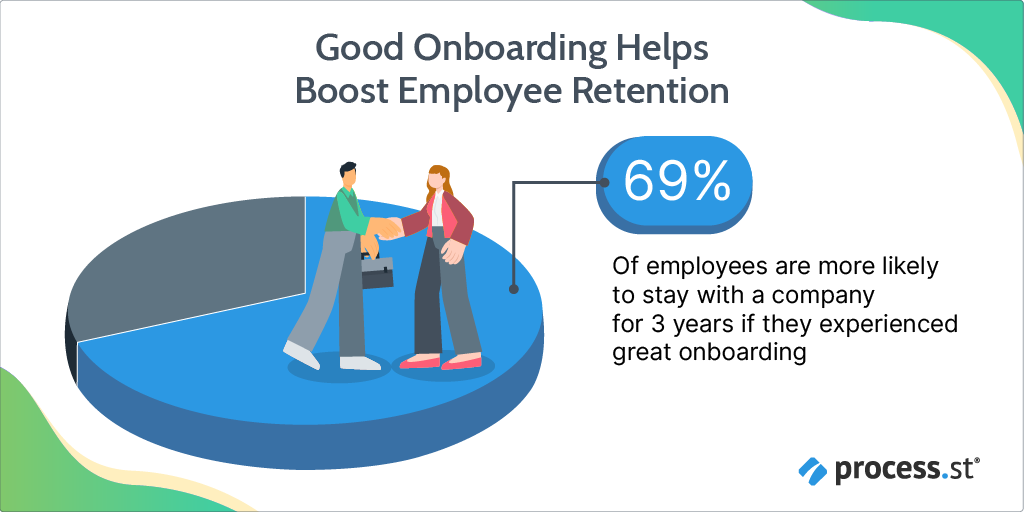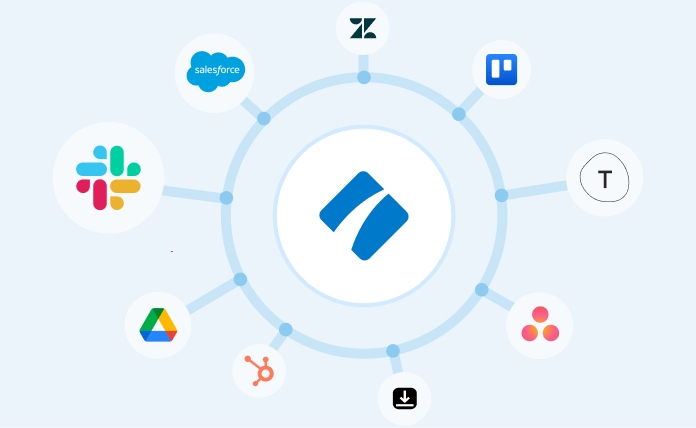Boost engagement, spark human connection, make new hires feel welcome with our no-code onboarding tool.
Onboarding Checklist: Employee Retention in 5 Easy Steps
Employee onboarding is extremely important. Hot take, I know. But seriously, with the Great Resignation and the trend of quiet quitting affecting organizations all over, now is not the time to skimp on good onboarding.
Just in case you need some convincing, let’s look at the numbers.
Data shows us that 20% of employee turnover happens in the first 45 days of the job. Employees are also 18 times more committed to an employer when they had a good onboarding experience. Not only that, good onboarding can improve employee retention by as much as 82%.
However, only 12% of employees think their organization has good onboarding.
That last number even shocked us and we’re complete nerds for onboarding. But don’t worry, we’re here to help you revamp your onboarding with our favorite tool ever: checklists.
This article will go through everything you need to know about onboarding checklists, covering:
- Onboarding checklist steps
- Benefits of using an onboarding checklist
- Challenges of using an onboarding checklist
- Best practices for using an onboarding checklist
- Onboarding checklist software

What is onboarding?
Onboarding is a critical process for any organization that wants to ensure the successful integration and retention of new employees or clients. It refers to the set of activities and tasks that are designed to help a new hire transition smoothly into their role and become a productive member of the team.
At its core, onboarding is about more than just paperwork and orientation sessions. It is about creating an engaging and supportive experience that sets the foundation for a positive employee-employer relationship.
By providing new hires with the necessary information, resources, and support, onboarding helps them understand their role within the company, become familiar with the organization’s culture and values, and establish connections with their colleagues.
The onboarding process typically starts even before the employee’s first day on the job. It begins with tasks such as sending out necessary paperwork, collecting essential information, and ensuring that the new hire has all the resources they need to hit the ground running.
This can include providing access to company systems and tools, setting up email accounts, and sharing important company policies and procedures.
Once the employee starts, onboarding continues with activities such as introducing them to key team members, providing a comprehensive orientation to the organization, and offering job training and development opportunities.
For successful onboarding, it is also important to address any questions or concerns the new hire may have, as well as provide ongoing support and feedback.
Benefits of an onboarding checklist
Using an onboarding checklist is crucial for a smooth and efficient onboarding process. It helps organizations streamline the employee onboarding experience and ensure that all necessary onboarding activities are completed in a timely manner.
Here are five key benefits of using an onboarding checklist:
Enhanced organization
An onboarding checklist acts as a roadmap, guiding both HR professionals and new hires through the onboarding process. It helps keep track of tasks, ensuring that nothing is missed or forgotten. This promotes better organization and reduces the chances of important steps being overlooked.
Consistency
With an onboarding checklist, organizations can maintain consistency across all employees’ onboarding experiences. It ensures that each new hire goes through the same process, receives the necessary information and resources, and completes the required tasks.
This consistency helps establish a strong foundation for company culture and ensures that employees start their journey on equal footing.
Compliance
An onboarding checklist includes essential legal and administrative tasks, such as filling out tax forms, signing contracts, and reviewing company policies. By using a checklist, organizations can ensure that all necessary legal and compliance requirements are met. This helps mitigate potential risks and keeps the organization in line with regulations.
Time-savings
An onboarding checklist helps HR professionals save time by providing a standardized process that can be used for every new hire. With a clear checklist, HR can efficiently complete tasks and gather necessary documentation, reducing administrative burdens and freeing up time for other important responsibilities.
Improved employee experience
A well-structured and organized onboarding process, facilitated by a checklist, sets the stage for a positive employee experience. It demonstrates that the organization values its new hires and is committed to their success. By providing all the onboarding materials, necessary information, resources, and support from day one, employees feel more confident, engaged, and ready to contribute to the company’s goals.
Types of onboarding checklists
When it comes to onboarding new employees, not all onboarding checklists are created equal. In fact, there are various types of onboarding checklists that organizations can utilize to ensure a smooth and comprehensive onboarding process. Let’s explore some of these different types:

Basic employee onboarding checklist
This type of checklist focuses on the essential tasks that need to be completed for the employee onboarding process. It typically includes items such as:
- Completing employee forms and tax forms
- Reviewing company policies
- Setting up employee benefits and direct deposit
- Giving them access to the employee handbook/company handbook
- Providing necessary equipment and resources
- Gifting company swag
- Starting team introductions
You can even use checklists during the hiring process. There are lots of hire checklist templates out there to help you get started.
Role-specific onboarding checklist
For organizations with diverse job functions and departments, a role-specific onboarding checklist can be beneficial. This checklist is tailored to the specific requirements and responsibilities of a particular role, providing new employees with the necessary training, resources, and introductions to excel in their position.
It may include tasks such as job-specific training, meeting key team members, and familiarizing new employees with relevant tools and systems.
Remote onboarding checklist
With the rise of remote work, organizations now need to adapt their onboarding processes to accommodate remote employees. A remote onboarding checklist includes tasks and activities specifically designed for virtual onboarding, such as:
- Setting up remote access to company systems
- Conducting virtual introductions with team members
- Providing a comprehensive overview of remote work policies and communication tools
- Defining performance goals
- Setting up remote any office equipment
Comprehensive onboarding checklist
As the name suggests, a comprehensive onboarding checklist encompasses all aspects of the onboarding process. It includes not only administrative tasks but also incorporates important cultural and social integration elements.
This type of checklist encompasses:
- Company culture
- Values and mission
- Team-building activities
- Mentorship programs
- Ongoing support to ensure a new hire’s successful assimilation into the organization
Compliance checklist
Particularly important for industries with strict legal and regulatory requirements, a compliance checklist ensures that new hires complete all necessary forms and training to meet compliance standards.
This may include tasks such as background checks, safety training, and signing confidentiality agreements. By utilizing a compliance checklist, organizations can mitigate risks and demonstrate their commitment to legal and ethical practices.
Extended onboarding checklist
Some companies opt for an extended onboarding process to provide new employees with a more immersive and in-depth experience. This type of checklist extends beyond the initial few weeks to include ongoing activities and milestones. It may include periodic check-ins with the new hire, additional training opportunities, and opportunities for mentorship and professional development.
5 steps to create an effective onboarding checklist
By following these five steps, you can turn your onboarding program into a comprehensive checklist that sets employees up for success:

Step 1: Identify key onboarding tasks
The first step in creating an effective onboarding checklist is to identify the key tasks that need to be completed during the onboarding process. This may include administrative tasks like completing tax forms and setting up benefits, as well as providing access to necessary equipment and resources.
Additionally, consider including tasks that introduce new hires to the company culture, such as attending an orientation session or meeting key team members. By identifying these tasks, you create a roadmap for new employees to follow.
Step 2: Sequence the tasks
Once you have identified the key tasks, it is important to sequence them in a logical order. Start with essential administrative tasks that need to be completed early on, such as filling out paperwork and setting up necessary accounts.
Step 3: Set timelines and deadlines
Then, gradually introduce tasks that help new hires acclimate to the company, such as attending team meetings or training sessions. By sequencing the tasks, you ensure that new employees progress through the onboarding process in a structured and organized manner.
To keep the onboarding process on track, it is important to set timelines and deadlines for each task on the checklist. This helps new hires understand expectations and allows them to plan their time accordingly. Consider assigning specific due dates for tasks such as completing paperwork or attending training sessions.
However, also provide flexibility for tasks that may require more time or may be dependent on other factors. Clear timelines and deadlines help keep the onboarding process efficient and ensure that new hires are not overwhelmed with too many tasks at once.
Step 4: Assign responsibility
An effective onboarding checklist should also include assigning responsibility for each task. Clearly specify who is responsible for completing each task, whether it be HR personnel, a manager, or the new hire themselves. Assigning responsibility ensures accountability and ensures that tasks are not missed or overlooked. It also facilitates communication and coordination between different stakeholders involved in the onboarding process.
Step 5: Continuously evaluate and improve
The final step in creating an effective onboarding checklist is to continuously evaluate and improve the process. Solicit feedback from new hires about their onboarding experience and make necessary adjustments to the checklist based on their feedback.
Additionally, regularly review the checklist to ensure it remains up to date with any changes in company procedures or policies. By continuously evaluating and improving the onboarding checklist, you can enhance the efficiency and effectiveness of the onboarding process, ultimately leading to higher employee satisfaction and retention.
Free onboarding checklist template
To help you put this all together, we’ve made an onboarding checklist template, which you can access for free below. It includes everything we covered above, plus some extras.
This template lays everything out in the most effective way for a great onboarding experience. It’s ready to use as-is or it can be completely customized to suit your specific needs.







 Workflows
Workflows Forms
Forms Data Sets
Data Sets Pages
Pages Process AI
Process AI Automations
Automations Analytics
Analytics Apps
Apps Integrations
Integrations
 Property management
Property management
 Human resources
Human resources
 Customer management
Customer management
 Information technology
Information technology



